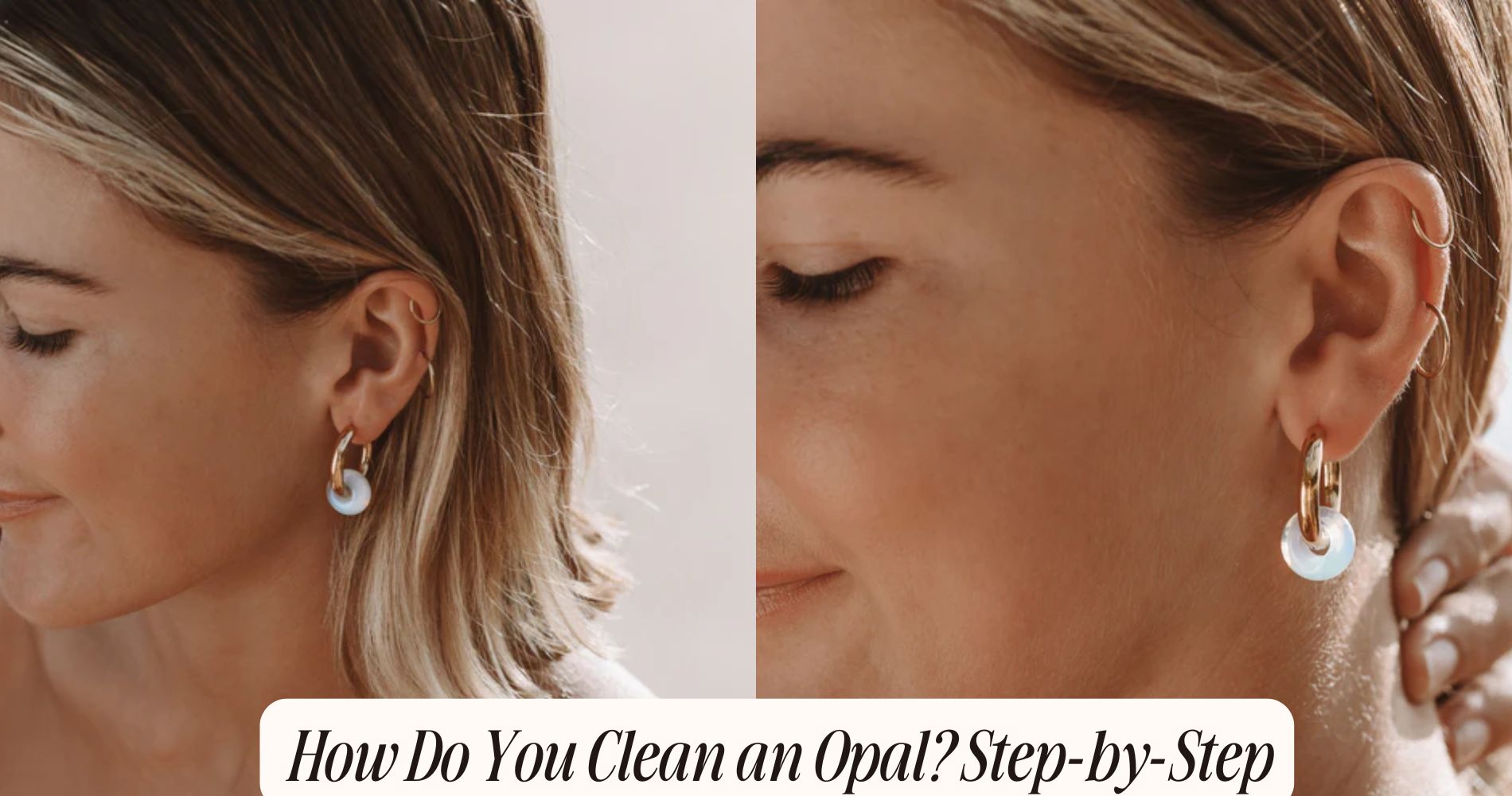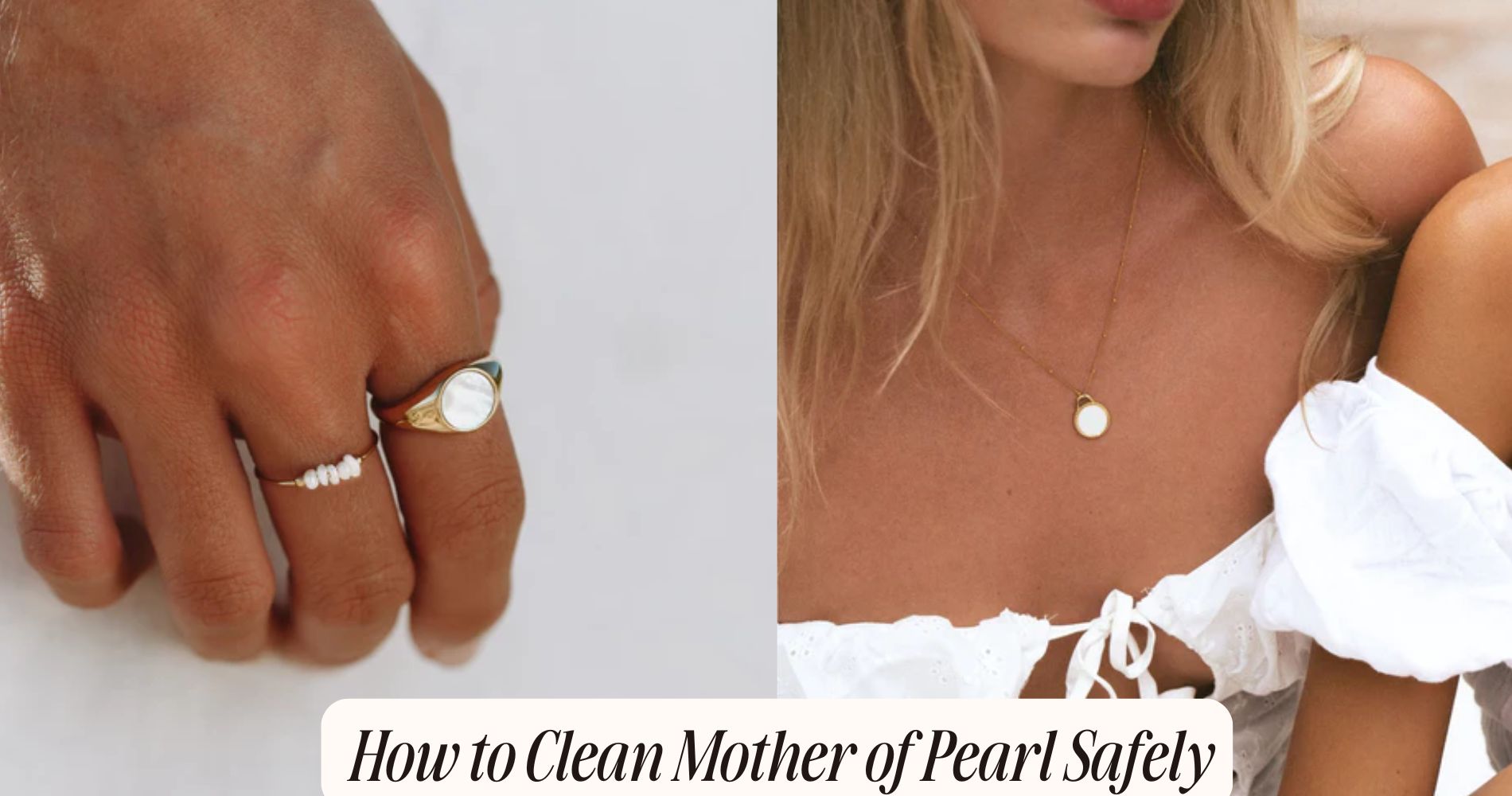
How Do You Clean an Opal? Step-by-Step
Understanding Opal Characteristics
Understanding the unique characteristics of opals is vital for proper care and maintenance. Opals form through a natural process where silica and water seep into cracks in the earth, resulting in various opal types, such as precious and common opals. The value of an opal largely depends on its color play, clarity, and overall durability.
Opal colors range from vibrant reds and greens to deep blues and yellows, each influencing the stone's appeal and market value. While opals are renowned for their stunning visual properties, they can be relatively softer compared to other gemstones, which means they require careful handling to avoid scratches and damage.
You may encounter numerous opal myths suggesting that these stones bring bad luck or are too fragile for everyday wear. However, understanding their history reveals that opals have been cherished for centuries, prized for their unique beauty rather than feared.
Proper opal care involves keeping them away from harsh chemicals and extreme temperatures to maintain their luster and value. By recognizing these characteristics, you can guarantee your opals remain stunning and well-preserved for years to come.
Necessary Cleaning Supplies
To clean your opal effectively, you'll need specific tools and safe cleaning solutions. Gathering a soft cloth, a gentle brush, and a bowl of lukewarm water is essential for protecting the stone's delicate surface.
Additionally, using mild soap or specialized jewelry cleaner guarantees you won't damage the opal during the cleaning process.
Essential Tools Required
Cleaning an opal requires a few vital tools to guarantee you maintain its stunning appearance without causing damage. To begin with, you'll need a soft-bristle toothbrush or a gentle brush specifically designed for gemstone care. This will help you remove dirt and debris without scratching the opal's surface.
Next, a lint-free microfiber cloth is important for drying and polishing your opal after cleaning. It prevents lint and fibers from sticking to the gemstone, assuring peak gemstone preservation. A shallow bowl is also necessary for holding the cleaning solution while you work.
Additionally, consider having a soft drying cloth on hand for any moisture that remains post-cleaning. If you own a jewelry cleaning kit, including a pH-balanced cleaner, it can also be beneficial for opal care, though you'll need to verify it's suitable for use on opals.
Lastly, a pair of tweezers will help you handle the opal safely, minimizing the risk of damage during the cleaning process. By gathering these essential tools, you'll be well-equipped for effective and safe opal maintenance.
Safe Cleaning Solutions
Choosing the right cleaning solutions is just as important as having the right tools for maintaining your opal's beauty.
First and foremost, avoid harsh chemicals that can damage your gemstone. Instead, opt for natural cleaners like a mild soap mixed with warm water. This gentle solution effectively removes dirt without risking harm to the opal.
Be cautious of cleaning myths that suggest using vinegar or other acidic substances. These can erode the opal's surface and diminish its luster.
Additionally, steer clear of abrasive cleaners or scrubbing pads, which can scratch the opal and compromise its integrity.
When cleaning, use a soft cloth or a soft-bristled brush to apply your natural cleaner. Always rinse thoroughly with clean water to remove any soap residue, and then dry with a soft, lint-free cloth.
Preparing Your Cleaning Area
Before you start the cleaning process, it's essential to set up a suitable workspace that minimizes the risk of damage to your opal.
Begin by selecting a flat, stable surface, ideally covered with a soft cloth to cushion the stone. This will help prevent scratches on both the opal and the surface beneath it.
Next, make certain your cleaning environment is well-lit. Good lighting allows you to see any dirt or grime on the opal, enabling a more thorough cleaning.
Keep your cleaning tools organized and at hand, such as a small bowl for water, a soft brush, and microfiber cloths.
Consult your preparation checklist to confirm you have all necessary materials before proceeding.
Remove any potential hazards from your workspace, such as loose items or sharp objects, that could accidentally come into contact with your opal.
Inspecting the Opal
With your workspace properly prepared, inspecting the opal is the next step in the cleaning process.
Begin by examining the opal under a bright, focused light to reveal any inclusions, scratches, or blemishes. This is vital for effectively using opal inspection techniques.
Utilize a jeweler's loupe or magnifying glass to closely evaluate the opal's surface and internal structure. Look for variations in color and pattern, as these factors greatly influence the stone's value.
As you evaluate opal quality, pay attention to the play-of-color, which refers to the iridescent flashes that give opals their unique character. The intensity and distribution of these colors are key indicators of quality.
Additionally, assess the opal's clarity; higher clarity generally correlates with greater value.
Make notes of any imperfections or features that stand out, as this information can guide your cleaning process.
Remember, an opal's delicate nature means that any damage could worsen during cleaning, so understanding its condition beforehand is important.
Following these steps guarantees that you're well-prepared to clean your opal effectively and maintain its beauty.
Cleaning With Mild Soap
To clean your opal effectively, start by mixing a solution of lukewarm water and a few drops of mild soap in a small bowl. Confirm the soap is free of harsh chemicals that could damage your opal's delicate surface. This mixture will help you maintain the opalescent sheen that makes your gemstone unique.
Next, take a soft, lint-free cloth or a soft-bristled toothbrush and dip it into the soapy solution. Gently wipe the surface of your opal, focusing on any areas where dirt or residue may have built up.
It's essential to avoid using any abrasive materials, as they can scratch the gemstone and diminish its beauty. For gemstone care, remember to apply minimal pressure while cleaning. The goal is to lift away grime without risking harm to the opal.
If necessary, you can repeat this process until the opal looks clean, but always use caution. Once you've thoroughly cleaned the surface, you'll be able to admire the vibrant colors and opalescent sheen that characterize your opal.
Proper cleaning will confirm your gemstone continues to sparkle for years to come.
Rinsing the Opal
After you've cleaned your opal with the soapy solution, rinsing it properly is vital to remove any soap residue. Start by using lukewarm water for rinsing, as extreme temperatures can affect the stone's integrity.
Hold your opal under a gentle stream of water, making certain the entire surface is thoroughly rinsed. This method is one of the most effective opal rinsing techniques, as it minimizes the risk of scratching the stone.
Avoid using a high-pressure faucet or spray, since this can lead to chipping or cracking. Instead, consider filling a bowl with clean water and gently submerging the opal. This technique also helps to avoid potential damage.
Rinsing best practices also include inspecting the opal after rinsing. Look for any remaining soap bubbles or residues; if necessary, repeat the rinsing process.
Always make sure that your hands are clean before handling the rinsed opal, as oils and dirt can recontaminate it. Once you've rinsed your opal thoroughly, you'll prepare it perfectly for the next step in your cleaning process.
Drying Techniques
Proper drying techniques are essential for maintaining the beauty and durability of your opal. After rinsing, you have a few effective options to take into account.
First, air drying is a gentle method that allows moisture to evaporate naturally. Place your opal on a drying rack in a well-ventilated area, guaranteeing there's minimal humidity to prevent prolonged moisture exposure.
Alternatively, towel drying can be effective. Use a soft, lint-free drying cloth to gently pat the surface of the opal dry. Avoid rubbing, as this can lead to surface damage.
If you choose to employ sun drying, be cautious; excessive heat exposure can cause cracking or fading of the opal's colors. It's best to limit direct sunlight and instead opt for indirect light.
Regardless of your method, maintaining humidity control is key to preventing moisture-related issues. Avoid drying your opal in overly humid environments, as this can prolong drying times and increase the risk of damage.
Whichever technique you select, make sure that your opal is completely dry before storing it to preserve its integrity and beauty.
Avoiding Harsh Chemicals
When cleaning your opal, it's essential to use gentle cleaners to prevent damage.
Harsh chemicals can strip the stone of its natural luster and cause long-term harm.
Stick to safe cleaning solutions specifically designed for delicate gemstones to guarantee your opal remains vibrant and intact.
Importance of Gentle Cleaners
Using gentle cleaners is vital for maintaining the integrity of opals, as harsh chemicals can cause irreparable damage. Opals are delicate gemstones that can be negatively affected by strong acids, alkalis, or abrasive agents. These substances can lead to surface etching, discoloration, or even structural weakening.
When cleaning your opal, it's important to choose safe materials that won't compromise its beauty or durability. Instead of reaching for conventional cleaning products, opt for mild soap and warm water.
During the cleaning process, employ gentle scrubbing techniques using a soft, lint-free cloth or a soft-bristled toothbrush. This approach guarantees that you're removing dirt and debris without risking scratches or damaging the opal's surface.
Always remember, the goal is to preserve the opal's vibrant play-of-color. Harsh chemicals may offer quick results, but the long-term consequences can be devastating.
Safe Cleaning Solutions
Selecting safe cleaning solutions is vital for preserving the beauty of your opal. When cleaning your opal, it's important to choose options that won't damage the stone.
Natural cleaners are an excellent choice as they're gentle and effective. You can create a simple solution using mild soap and warm water. Mix a few drops of a natural dish soap with water, then soak your opal briefly.
If you prefer commercial solutions, verify they're specifically designed for delicate gemstones. Look for products labeled as safe for opals or other porous stones. Always read the ingredients list to confirm there are no harsh chemicals that could affect your opal's structure or color.
Avoid using anything abrasive, as scrubbing can scratch the surface. Instead, use a soft cloth or a soft-bristle toothbrush to gently clean any crevices.
After cleaning, rinse your opal thoroughly under lukewarm water to remove any soap residue. By selecting the right cleaning solutions, you'll maintain the vibrancy and integrity of your opal, making sure it remains a cherished piece in your collection for years to come.
Common Chemicals to Avoid
To keep your opal in ideal condition, it's crucial to steer clear of certain harsh chemicals. Chemicals like bleach, ammonia, and alcohol can cause detrimental chemical reactions that compromise the integrity of the stone. These substances can strip away the opal's natural oils, leading to dryness and cracking.
When it comes to opal care, avoid any cleaning products that contain strong solvents or acids, as these can lead to irreversible damage. Household cleaners often contain abrasive agents that can scratch the surface of your opal, diminishing its luster and brilliance.
Additionally, steer clear of ultrasonic cleaners, which use high-frequency sound waves to clean jewelry. These devices can generate vibrations that may fracture or chip your opal. Remember, opals are porous and sensitive to sudden changes in temperature and humidity.
Instead, opt for gentle, pH-neutral cleaning solutions, or simply use warm, soapy water and a soft brush. By being mindful of the chemicals you use, you'll guarantee your opal retains its beauty for years to come.
Prioritize safe cleaning practices to maintain the value and appearance of your cherished gemstone.
Storing Your Opal Safely
It's vital to store your opal properly to maintain its beauty and integrity. When considering opal storage, choose a soft, padded jewelry box or a dedicated velvet pouch to prevent scratches and damage. Avoid placing it alongside other gemstones, as harder stones can easily scratch the delicate surface of your opal.
Temperature and humidity control are also fundamental for opal protection. Store your opal in a cool, dry place, as extreme heat or moisture can cause it to crack or lose its vibrancy. If you live in a humid environment, consider using silica gel packets in your storage area to help absorb excess moisture.
Additionally, avoid exposing your opal to direct sunlight for extended periods, as this can fade its colors. If you're storing opals in a safe or drawer, wrap them in a soft cloth to provide an extra layer of cushioning.
Lastly, always handle your opal with clean hands to avoid transferring oils or dirt that could affect its appearance. By following these guidelines, you'll guarantee your opal remains stunning and retains its unique characteristics for years to come.
Regular Maintenance Tips
Maintaining your opal's luster and integrity requires regular care to prevent damage and deterioration. Start by conducting routine checks to assess your opal's condition. Look for any cracks, chips, or signs of wear that may compromise its beauty. If you spot any issues, consult a professional jeweler for repairs.
Opal care is essential, particularly since these stones are sensitive to temperature changes and exposure to chemicals. To protect your opal, avoid wearing it during activities that may subject it to impacts or harsh substances.
When cleaning, use a soft, damp cloth to gently wipe the stone. Never use ultrasonic cleaners or harsh chemicals, as they can damage the opal's surface.
Store your opal in a soft pouch or a separate compartment in your jewelry box to prevent scratches from other jewelry. Regularly check the settings of your opal jewelry to guarantee that stones are secure and not at risk of falling out.
Frequently Asked Questions
Can I Use Ultrasonic Cleaners on Opals?
You shouldn't use ultrasonic cleaning for opals. The intense vibrations can damage these delicate gems. For effective opal care, stick to gentle cleaning methods that preserve their beauty and structural integrity.
How Often Should I Clean My Opal?
You should clean your opal regularly for ideal maintenance. Generally, every one to three months works well, but adjust based on wear. Follow opal maintenance tips to preserve its beauty and prevent damage effectively.
What Should I Do if My Opal Cracks?
If your opal cracks, you should seek professional help immediately. Proper opal care and maintenance can prevent further damage. Avoid DIY repairs, as they might worsen the crack or affect the stone's appearance.
Is It Safe to Expose Opals to Sunlight?
Exposing opals to sunlight can cause fading and damage. For ideal opal care, limit direct sunlight exposure to preserve their vibrant colors and prevent potential cracking or deterioration due to excessive heat and UV radiation.
Can I Use Vinegar for Cleaning Opals?
You shouldn't use vinegar for cleaning opals. Its acidic effects can damage the stone's surface. Opt for gentler cleaning methods, like mild soap and water, to preserve your opal's beauty and integrity.
Conclusion
In conclusion, cleaning your opal requires attention to detail and the right techniques. By following the steps outlined—understanding its characteristics, using mild soap, and avoiding harsh chemicals—you can maintain its brilliance and integrity. Regular inspection and proper storage will further enhance its longevity. With these practices in place, your opal will remain a stunning and cherished piece for years to come. Prioritize care, and you'll guarantee your opal stays radiant and beautiful.























Leave a comment
This site is protected by hCaptcha and the hCaptcha Privacy Policy and Terms of Service apply.